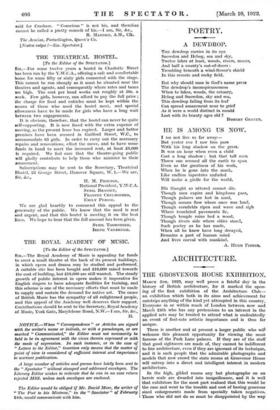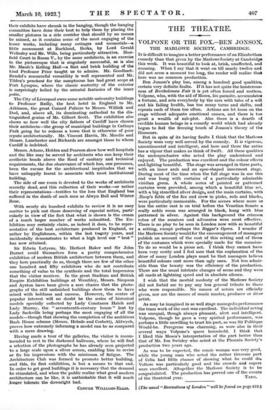ARCHITECTURE.
THE GROSVENOR HOUSE EXHIBITION.
MARCH 5m, 1923, may well prove a fateful day in the history of British architecture, for it marked the open- ing of the first exhibition of the Architecture Club— an exhibition which both in its aims and achievement far outstrips anything of the kind yet attempted in this country. Everyone in or within reach of London between now and March 24th who has any pretensions to an interest in the applied arts may be trusted to attend what is undoubtedly an event of first-rate artistic importance and is thus far unique.
There is another and at present a larger public who will welcome this pleasant opportunity for viewing the most famous of the Park Lane palaces. If they are of the stuff that good sightseers are made of, they cannot be indifferent to fine architecture, even if they are ignorant of its technique, and it is such people that the admirable photographs and models that now crowd the state rooms at Grosvenor House will entrap into a direct and intelligent interest in modem architecture.
In the high, gilded rooms any but photographs- on an heroic scale are dwarfed into insignificance, and it is well that exhibitors for the most part realized that this would be the case and went to the trouble and cost of having generous sized enlargements made from specially taken negatives. Those who did not do so must be disappointed by the way
their exhibits have shrunk in the hanging, though the hanging committee have done their best to help them by placing the smaller pictures in a side corridor that should by no means be missed, as it contains some of the most engaging of the lesser works, including many cottages and memorials—a little 'monument at Buckland, Berko, by Lord Gerald Wellesley and Mr. Wills, being particularly attractive. Sher- field Court in Room V., by the same architects, is an exercise in the picturesque that is singularly successful, as is also Mr. Maufe's Kelling Hall--a flint and brick building of the kind Professor Prior taught us to admire. Mr. Goodhart-
Renders resourceful versatility is well represented and Mr. Tilden's penchant for the sumptuous has had great scope at Port Lympne, where the classic austerity of the exterior is surprisingly belied by the oriental fantasies of the inner patio.
The City of Liverpool owes some notable university buildings to Professor Reilly, the best hotel in England to Mr.
Atkinson, the great Cunard Palazzo to Messrs. Willink and
Dod, and, above all, its dominating cathedral to the dis- tinguished .genius of Mr. Gilbert Scott. The exhibition also shows us how well the city fathers of Cardiff have chosen their architects—the group of municipal buildings in Cathays Park going far to redeem a town that is otherwise of poor repute architecturally. Mr. Vincent Harris, Mr. Moodie and Messrs. Lanchester and Rickards are amongst those to whom Cardiff is indebted.
Messrs. Adams, Holden and Pearson show how well hospitals and the like may be served by architects who can keep their aesthetic heads above the flood of sanitary and technical requirements, the due observance of which has, one presumes, been the excuse for the architectural ineptitudes that we have unhappily learnt to associate with most institutional building.
The side of one room is devoted to the works of architects recently dead, and this collection of their works—or rather their representations—testifies to the loss that Rpgland has suffered in the death of such men as Alwyn Ball and Winter Rose.
With nearly six hundred exhibits to review it is no easy matter to pick out those deserving of especial notice, parti- cularly in view of the fact that what is shown is the cream of a much larger number of works submitted. The Ex- hibition may certainly claim, as indeed it does, to be repre- sentative of the .best architecture produced in England, or rather by Englishmen, within the last twanty years, and incidentally demonstrates to what a high level our " best " has now attained.
Sir Edwin Lutyens, Mr. Herbert Baker and Sir John Burnet could themselves form a pretty comprehensive exhibition of modern British architecture between them, and they here practically do so, though there are few of the other one hundred and fifty exhibitors who do not contribute something of value to the synthesis and the total impression that the visitor receives. In the great Stadium and British Empire Exhibition buildings at Wembley, Messrs. Simpson and Ayrton have been given a rare chance that the photo- graphs of the still unfinished buildings show them to have seized with boldness and success. However, the centre of popular interest will no doubt be the series of historical models specially collected by Lady Constance Hatch and Lady Murray, the "seventeenth-century house" lent by Lady Sackville being perhaps the most engaging of all the models—though that showing the completion of the ambitious 'Bush House scheme (Messrs. Hehnle and Corbett), Aldwych, proves how extremely informing a model can be as compared with a mere drawing.
Having made a tour of the galleries, the visitor is recom- mended to rest in the darkened ballroom, where he will find a selection of the photographs he has already seen projected to a large scale upon a silver screen, enabling him to revise or fix his impressions with the minimum of fatigue. The Architecture Club was formed to promote better building, and this, its first exhibition, is but a means to that end. In order to get good buildings it is necessary that the demand
be stimulated, and when the public realize what good modern architecture can be like, it is unthinkable that it will much flonger tolerate the downright bad.
CLOUGH WILLIAMS-FT











































 Previous page
Previous page